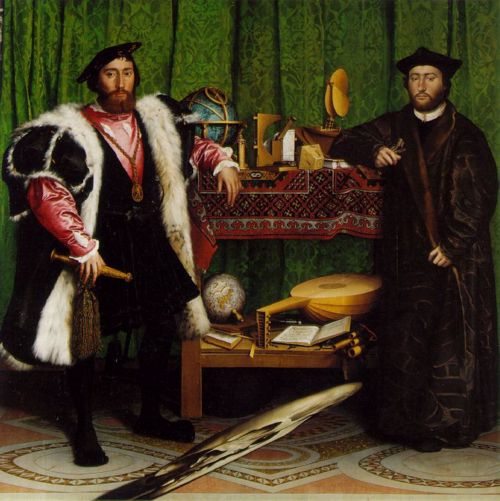The Ambassadors (painting): Difference between revisions
Jump to navigation
Jump to search

imported>Hayford Peirce m (The Ambassadors moved to The Ambassadors (painting): I am going to create a The Ambassadors disambig page -- I feel sure that the novel by Henry James is more famous than the painting) |
imported>Ro Thorpe mNo edit summary |
||
| Line 1: | Line 1: | ||
{{subpages}} | {{subpages}} | ||
Jean de Dinteville and Georges de Selve ('''The Ambassadors''')<ref>[http://gallery.euroweb.hu/html/h/holbein/hans_y/1535a/ The Ambassadors (1533) in London]</ref> is a painting by [[Hans Holbein the younger]] | Jean de Dinteville and Georges de Selve ('''The Ambassadors''')<ref>[http://gallery.euroweb.hu/html/h/holbein/hans_y/1535a/ The Ambassadors (1533) in London]</ref> is a 1533 painting by [[Hans Holbein the younger]]. It is displayed at the [[National Gallery]] in London, England, having been bought in 1890. It is painted with a meticulous eye for detail, and its inner meaning is controversial. On the right is Georges de Selve, aged 25, Bishop of Lavaur. According to [[John North]]<ref>[http://www.amazon.com/Ambassadors-Secret-Holbein-World-Renaissance/dp/1852853301 The Ambassador's Secret: Holbein and the World of the Renaissance, ISBN-10: 1852853301]</ref> the scene depicted is exactly 1,500 years after [[Jesus Christ|Christ's]] [[crucifixion]], that is [[Good Friday]] (April 11th) 1533, which gives the anamorphic skull particular significance. | ||
[[Image:Ambassadors.jpg|Left|500px]] | [[Image:Ambassadors.jpg|Left|500px]] | ||
Revision as of 13:31, 3 December 2008
Jean de Dinteville and Georges de Selve (The Ambassadors)[1] is a 1533 painting by Hans Holbein the younger. It is displayed at the National Gallery in London, England, having been bought in 1890. It is painted with a meticulous eye for detail, and its inner meaning is controversial. On the right is Georges de Selve, aged 25, Bishop of Lavaur. According to John North[2] the scene depicted is exactly 1,500 years after Christ's crucifixion, that is Good Friday (April 11th) 1533, which gives the anamorphic skull particular significance.
